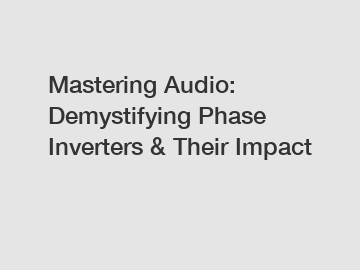Mastering Audio: Demystifying Phase Inverters & Their Impact
Welcome to the fascinating world of audio mastering! In this blog post, we will unravel one of the lesser-known yet crucial aspects of audio processing – phase inverters. Often seen as a mystical tool, phase inverters play a significant role in determining the quality and clarity of sound. With our expertise and years of experience in audio engineering, we will demystify this concept, unraveling its impact on the final audio output.
Understanding Phase Inverters:
In audio production, phase refers to the timing relationship between two or more sound waves. When sound waves are in phase, they combine constructively, resulting in a louder and more focused sound. However, when they are out of phase, they interfere destructively, causing cancellation and sonic degradation.

Phase inverters, also known as phase reversal or polarity inverters, manipulate the phase relationship between audio signals. By flipping the polarity of the waveform, they can either bring two sources in phase or put them out of phase. This inversion ensures precise control over the signal's phase and can greatly affect the audio's perceived spatial imaging and overall sonic quality.
Impact on Sound and Audio Quality:
The primary use of phase inverters is found in mixing and mastering processes, where attaining a cohesive and balanced sound is paramount. When utilized correctly, phase inversion can be a powerful tool for mitigating phase cancellation issues that may arise during recording or mixing.
A common example is the phase relationship between microphones placed near an instrument or amplifier. Due to the varying distances from the sound source, these signals may not be perfectly aligned, resulting in phase issues during playback. By applying phase inversion, audio engineers can often restore the original sound's integrity and prevent unwanted cancellation or phase-related artifacts.
Moreover, phase inversion can be employed creatively to create unique audio effects. This technique finds applications in sound design, electronic music production, and experimental audio processing. By manipulating the phase relationship between different tracks or elements, producers can achieve interesting stereo imaging, widening or narrowing the soundstage, or even creating intricate rhythmic patterns.
Best Practices and Challenges:
While phase inverters offer unprecedented control over audio signals, they are by no means a magic wand. Their usage requires a deep understanding of signal processing and an attentive ear.
Here are a few best practices when working with phase inverters:
1. Quality Monitoring: Use high-quality monitoring systems to accurately perceive the changes caused by phase inversion. This helps in identifying and resolving phase-related issues more effectively.
2. Solo and Blend: Isolate the problematic sound sources and evaluate their phase relationship in solo mode. Then, experiment with blending the signals to determine the optimum phase inversion settings that yield the desired results.
3. Incremental Adjustments: Small adjustments in phase inversion can have a significant impact on the overall sound. Make incremental changes and listen attentively to judge their effect before proceeding further.
Conclusion:
Understanding and utilizing phase inverters is an essential skill set for audio engineers, producers, and mastering professionals. These tools offer unparalleled control over phase relationships, empowering us to enhance audio quality, correct phase issues, and unleash creative possibilities.
With a combination of experience, expertise, and experimentation, audio professionals can master the art of phase inversion, elevating their audio productions to new heights. However, it is crucial to exercise caution and rely on trusted monitoring systems to ensure the desired outcomes are achieved.
Now that you’ve demystified the concept of phase inverters, go ahead and experiment with this powerful tool to unlock new sonic possibilities in your sound productions. Happy mastering!
Contact us to discuss your requirements of commercial inverters factory, commercial inverter systems, how does a 3 phase solar inverter work. Our experienced sales team can help you identify the options that best suit your needs.


